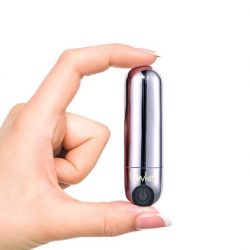Coding Sex: Startup Develops Building Blocks for AI Lovers
It’s a brave new world for orgasm training.

What makes a good lover?
This is the question Jon Driscoll ponders at his San Diego sex tech startup Hum. There, across from the original TOPGUN training base, he develops software for his line of smart sex toys. Despite the locale, Driscoll embraces more of a “make love, not war” work ethic.
“The first level of hooking up intimacy is pay attention,” he says during a Skype video call. “Don’t just do your own thing in your own world and let the other person be off in their world. Actually respond to what’s going on.”
Some people say the best sex happens when lovers move in sync. When a certain erotic intuition takes hold. Driscoll takes this notion to heart, having coded it into the Hum vibrator—an artificially intelligent sex toy billed as the first of its kind.
Underneath its silicone coating and phallic frame lie pressure sensors and a mini-computer. Together they track touch and motion, including vaginal contractions. The two motors, which allow the Hum to move back and forth, pick up this data and pulse to match the user’s speed and movement.
“As you interact with a vibrator it starts to reflect what you are doing,” he says. “Just feeding back what’s going on, kind of like a mirror, sort of creates this virtual person.”
“You have this sort of ability to influence it back and create a pattern within it based on what you are doing. And it’s similar to what happens when people have sex.”
ANNA
Promising to make this “virtual person” more convincing is ANNA—short for Artificial Neural Network, version A—which Driscoll began developing last December.
 |
An Artificial Neural Network is a learning algorithm modeled after the human brain. Instead of processing information through electrical and chemical signals, artificial neurons use math functions.
So unlike Hum’s current basic computer algorithm, ANNA learns from experience. It picks out patterns in data, and, while still in beta, feels more responsive.
“It has more of a personality, more of a feel to it that it has it own ‘ideas’ about the world,” Driscoll says.
For neural nets like ANNA to work, they must be trained to recognize patterns. In fact, ANNA is bootstrapped off Hum’s existing code. Yet it has already surpassed its predecessor in its ability to integrate motion and react quickly.
Unreleased and incomplete, we haven’t seen ANNA’s full potential. But Driscoll raises an interesting possibility that could have far-reaching benefits.
“What would it mean to train a neural net on 200 orgasms?” he asks.
Struggling to climax
Studies show that about 10% to 15% of women have trouble reaching orgasm, a condition the medical field calls anorgasmia. Over the past decade, the drug industry has tried to come up with pharmaceutical solutions, to create a “female Viagra” that will resurrect low libidos.
The venture is not without its criticisms.
On PBS News Hour, Dr. Adriane Fugh-Berman of Georgetown University Medical Center questioned the medical need. The real issue may be an imbalance between partners’ sex drives, not sexual dysfunction.
“I think we really need to question why we’re saying there is something necessarily wrong with a woman who has a lower libido than her partner. There is not a scientific norm for libido,” she says in the August 2015 interview.
Fugh-Berman’s TV appearance coincided with FDA approval for Addyi—the first pill the agency has ever OK’d to treat low sexual desire in women. She called it “dangerous” and “barely effective, if it’s effective at all.” Unlike Viagra, it works on the brain, not blood flow. It must also be taken every day, and may cause sudden unconsciousness.
For women who have trouble reaching climax—and want to do something about it—there must be a better way. And perhaps AI technology like Hum’s ANNA could play a role.
Back to those 200 orgasms…
When it comes to machine learning, considerable effort has focused on training computers on human language. IBM’s Watson, virtual assistants like Siri, and translation software show off progress in recent years.
While Driscoll’s work focuses on physical responses, the strides above invoke an aura of potential for sex—especially with the idea of training ANNA on hundreds of orgasms.
Driscoll wonders whether a neural net could help women have vaginal orgasms.
What would happen if Hum “climaxed” a lot? If it played out vibrations and patterns similar to collections of orgasms women have actually had?
“So women who have never experienced an orgasm can still experience the virtual feeling of what that feels like, the contractions,” he says, referring to both the rapid movement and slowing down of muscles.
“And if you do that enough will that teach someone to have an orgasm?”
The concept sounds similar to doing Kegel exercises, which strengthen the pelvic floor and vaginal walls. According to sexual health expert Dr. Jennifer Berman, Kegels can give women stronger orgasms, but won’t affect other factors getting in the way of pleasure—like hormones or emotions.
However, Kegels center around a woman contracting her pelvic muscles on her own, not having a device mimic real orgasms. So for women who simply never learned the power of the pelvic floor, perhaps an AI vibrator could jump in as sex therapist.
The future of AI sex toys
The future of AI sex toys is ripe for the picking. There’s likely much money to be made for people with the resources and passion to develop them. In 2014, the global market for sex toys was a whopping $15 billion, and it stands to grow. Some estimate it could reach $52 billion by 2020.
How exactly machine learning could stir up human sexuality remains to be seen. But you can imagine some incredible possibilities if sophisticated AI, similar to IBM’s Watson, were put toward sex. It could make us happier, and more fulfilled sexual beings.
There’s also a dark side to AI, which often rears its head in science fiction and banner headlines.
While many of use are inspired by innovation in self-driving cars and chatbots, there are outcries over how they may take over human jobs. Sensational news articles often direct this concern at sex robots: will they ruin human-human relationships? Is technology killing sex?
For Driscoll, he brings it back to his first level of intimacy: paying attention.
“What this really does is remind people to respond and listen,” he says. His technology is about learning about yourself and what feels good for you.
“If you are threatened by a vibrator, then maybe you need to up your game.”
Image sources: Hum
1 comment
Leave a reply
You must be logged in to post a comment.


















Is it possible for a female to increase her libido through machine learning and artificial intelligence? Can females achieve an orgasm with other men through machine learning and artificial intelligence?